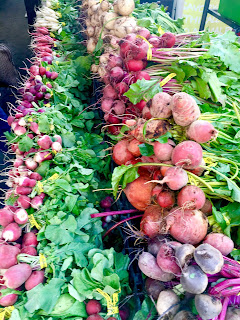A trip to the farmer's market at this time of year is a revelatory experience, the changing colors of the leaves on the trees reflected in the market haul of reds and greens in apples and pears, oranges and yellows and umbers in all varieties of pumpkins and squash. The cruciferous vegetables of winter are coming in, even as Indian summer golden peaches are still being sold alongside them. This is the perfect time for what I call "whole vegetable eating" -- sometimes called root-to-fruit, or some such rhyming variation. What's most important is not what it's named, but how it's done. I'll give you a little help.
As the weather turns cooler, we look to root vegetables and foods that start producing in autumn to last us through the winter. We know that carrots and beets are healthy root veggies, but often the greens (or carrot tops, in the case of carrots) are overlooked, or worse, removed before we can use them. And they're delicious!

I love serving the Greek dish skordalia, which is a whipped potato-garlic puree (try this with purple potatoes!) along with roasted beets and wilted beet greens. It's the perfect dish served warm or at room temp, so it's incredibly versatile. And it looks beautiful as well.

Just as we know these roots better than their stems and stalks, we know the stalks of celery and parsley better than celery root and parsnips -- though all parts of these veggies are tasty and worth exploring in their own right. I love using celery root raw, slicing it into a thin julienne and tossing it with homemade mayonnaise for celeriac remoulade, the simplest of French treats. And I love, especially during cold months, using celery root to replace potatoes by 80%, making a puree for all of the stews and slow-cooked braises I cook at this time of year.
Parsnips are another great substitute for potatoes, but they also provide a delicious pairing with roasted carrots -- they look a lot like white carrots anyway -- and their sweetness when roasted mimics that of carrots' sweetness, so they're great hit with a bit of acid, tossed in either a balsamic vinegar or some citrus juice before and after roasting. I also love a good celeriac or parsnip soup. They puree so nicely and they have a verdant undertone that potatoes don't. Again, they pair well with sweet and acidic, so I usually top off the soups with a maple gastrique or some kind of sweet-sour accompaniment.
 Though
usually summer squash is found -- you guessed it! -- in the summertime,
you can usually find zucchini and yellow squash well into the fall in
many markets. And often, the zucchini flowers are actually pumpkin
flowers (fiori di zucca in Italian), so these are also a part of
the pumpkin to be utilized in whole vegetable eating. We know we can
clean and roast pumpkin seeds. Of course the flesh itself works for
preparations from savory to sweet, and even the flowers of the pumpkins
are a great gastronomic delight -- stuffed, fried, sauteed and tossed in
a pasta or risotto. This is the definition of whole vegetable eating.
Though
usually summer squash is found -- you guessed it! -- in the summertime,
you can usually find zucchini and yellow squash well into the fall in
many markets. And often, the zucchini flowers are actually pumpkin
flowers (fiori di zucca in Italian), so these are also a part of
the pumpkin to be utilized in whole vegetable eating. We know we can
clean and roast pumpkin seeds. Of course the flesh itself works for
preparations from savory to sweet, and even the flowers of the pumpkins
are a great gastronomic delight -- stuffed, fried, sauteed and tossed in
a pasta or risotto. This is the definition of whole vegetable eating. |
| Stuffed zucchini flowers |
 |
| My homemade gnocchi with cherry tomatoes and chive blossoms |
Happy Harvest Season, everyone. Enjoy your autumns!








No comments:
Post a Comment